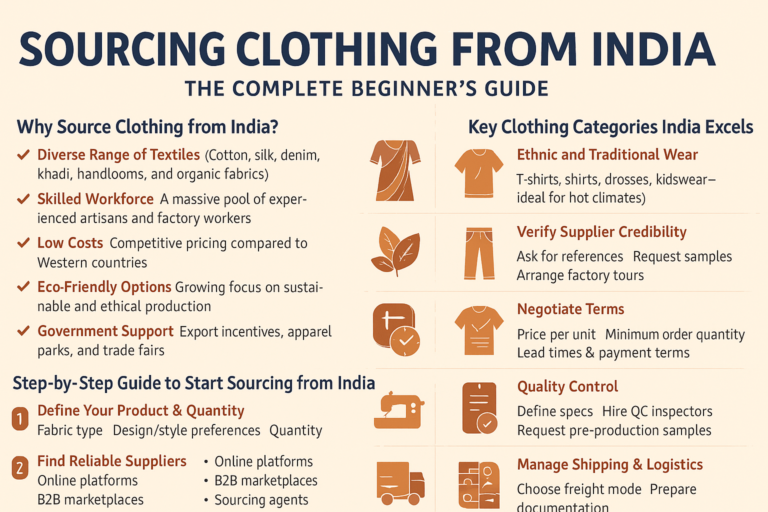- /
- By smallworldindia
Sourcing Clothing from India: The Complete Beginner’s Guide

Whether you are starting a fashion brand, operating a boutique, or growing your e-commerce business, sourcing clothing from India can offer high quality at competitive prices: India has long been a global powerhouse in textile and garment manufacturing, offering a rich blend of tradition, skilled labor, and modern production capabilities.
From comprehending India’s textile ecosystem to selecting the best suppliers and effectively handling the sourcing process, this guide covers everything a novice needs to know.
Why Source Clothing from India?
Centuries of craftsmanship, a vast array of raw materials, and an expanding modern infrastructure are the reasons behind India’s strength in the apparel industry. This is why it makes sense to source from India:
- ✅ Diverse Range of Textiles: Cotton, silk, denim, khadi, handlooms, and organic fabrics.
- ✅ Skilled Workforce: A massive pool of experienced artisans and factory workers.
- ✅ Low Costs: Competitive pricing compared to Western countries.
- ✅ Eco-Friendly Options: Growing focus on sustainable and ethical production.
- ✅ Government
Key Clothing Categories India Excels In
- Ethnic and Traditional Wear: Sarees, lehengas, kurtas, and hand-embroidered apparel.
- Cotton Garments: T-shirts, shirts, dresses, kidswear — ideal for hot climates.
- Handloom & Organic Apparel: Sustainable and artisan-made clothing.
- Denim and Streetwear: High-quality jeans, jackets, and casualwear.
- Private Label Manufacturing: Custom designs with low MOQs (Minimum Order Quantities).
Step-by-Step Guide to Start Sourcing from India
Step 1: Define Your Product & Quantity
Clearly outline what types of clothing you want:
- Type of fabric (viscose, cotton, silk, etc.)
- Preferences for design and style
- Quantity (each style’s MOQ ranges from 50 to 500+)
Step 2: Find Reliable Suppliers
You can discover suppliers via:
- Online Platforms: IndiaMART, TradeIndia, Fibre2Fashion, Global Sources
- B2B Marketplaces: Alibaba (filter by country), ExportersIndia
- Sourcing Agents: Help bridge communication, quality, and negotiation
- Trade Shows & Expos: Bharat Tex, India International Garment Fair (IIGF), and Tex-Styles India
👉 Tip: Always check for certifications like ISO, GOTS (organic), SEDEX, or SA8000 for ethical practices.
Step 3: Verify Supplier Credibility
Before placing any order:
- Ask for company profile and references
- Request samples (pay shipping, if needed)
- Arrange virtual or in-person factory tours
- Use third-party verification services (like SGS or Intertek)
Step 4: Negotiate Terms
Discuss:
- Price per unit (based on volume)
- Minimum Order Quantity (MOQ)
- Lead times and delivery schedule
- Payment terms (50% advance/50% before shipping is common)
- Shipping terms (FOB, CIF, or DDP)
👉 Pro Tip: Indians expect negotiation — start slightly lower than your target budget.
Step 5: Quality Control
Set clear quality standards from the beginning. You can:
- Define specs (fabric GSM, stitching count, wash durability)
- Hire QC inspectors or agencies to check goods before shipment
- Ask for pre-production samples and photos during production
Step 6: Manage Shipping & Logistics
India has ports in Mumbai, Chennai, Kolkata, and more. Choose:
- Air Freight for small, urgent shipments
- Sea Freight for large volumes
Documents you’ll need:
- Commercial Invoice
- Packing List
- Bill of Lading or Airway Bill
- Certificate of Origin
- Insurance (recommended)
You can also hire freight forwarders or customs brokers to simplify the process.
Common Challenges & How to Overcome Them
Challenge | Solution |
Language barrier or miscommunication | Use clear documentation and visuals |
Long lead times | Plan at least 60–90 days in advance |
Quality inconsistency | Insist on QC inspections at each stage |
Unclear pricing or hidden costs | Request detailed pro forma invoices |
Bonus: List of Popular Clothing Sourcing Hubs in India
- Tiruppur (Tamil Nadu): Knitwear and T-shirts
- Ludhiana (Punjab): Woolen & winter clothing
- Jaipur (Rajasthan): Hand block prints, ethnic wear
- Surat (Gujarat): Sarees and synthetic fabrics
- Delhi NCR: Fashionwear, western garments, private label units
- Mumbai: Fashion exports and premium garments
Final Thoughts
For fashion entrepreneurs, sourcing apparel from India is both a wise and economical decision. You can create a robust, dependable clothing supply chain based on India’s top-tier apparel ecosystem with the correct planning, supplier research, and quality controls in place.
India provides unparalleled variety, value, and quality, regardless of your business’s size.
🔍 Need Help?
https://smallworldindia.com/Thinking about sourcing from India but not sure where to start? Let me know — I can help you create a supplier list, draft emails, or guide you on trade fairs.

